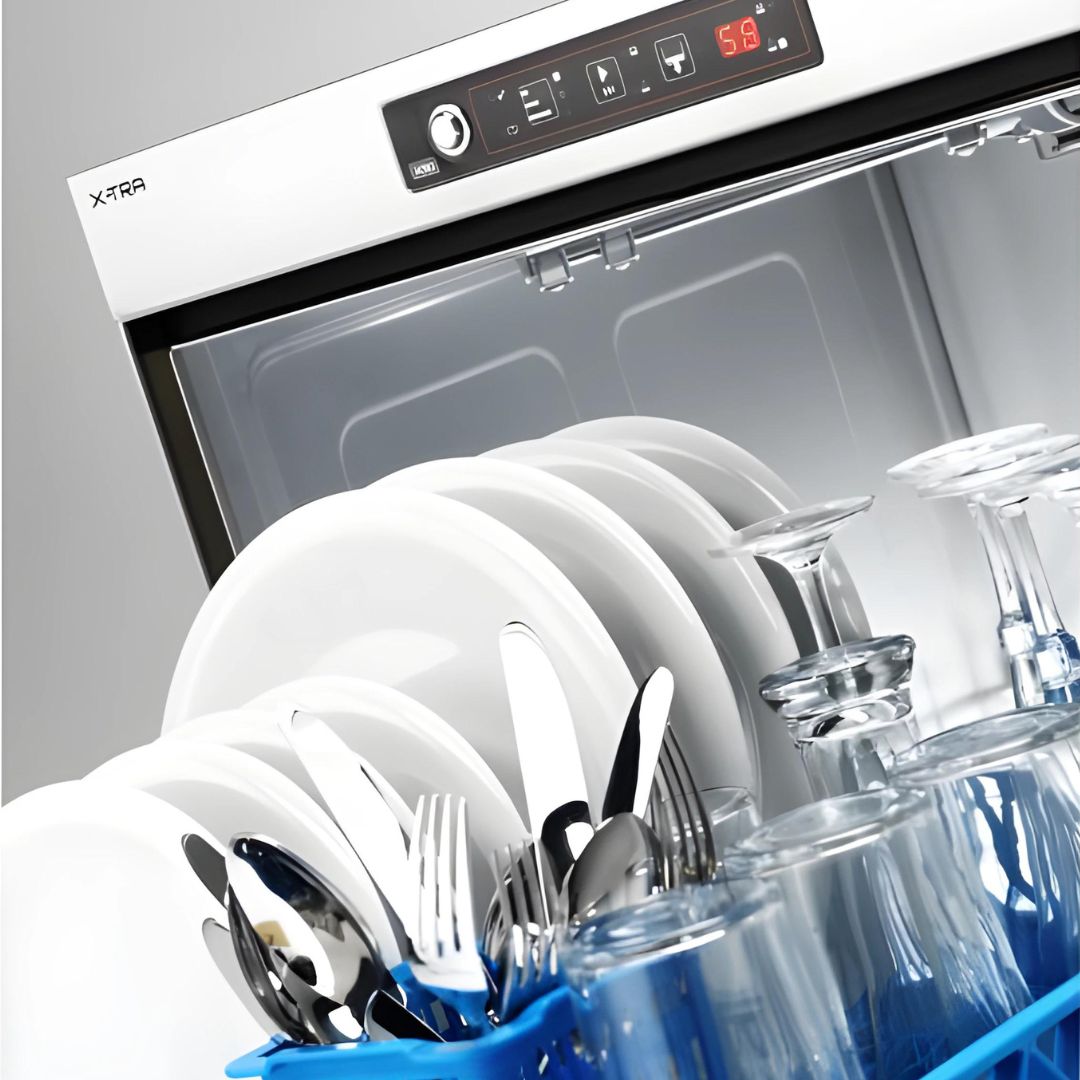How to choose an industrial dishwasher?
2024. 06. 03.

Dirty utensils deter guests, and attracts the food safety and hygiene supervision like a magnet. If you want your business to grow and serve more and more guests, buying an industrial dishwasher becomes inevitable in many ways.
But how do you choose between the many different designs, types and performances?
Before diving into the details, let's take a look at how industrial dishwashers work. The most important difference compared to dishwashers that have been known in households for a long time is that they wash and rinse the plates and glasses in 2-3 minutes. Industrial dishwashers typically clean with warm water and rinse with hot water (and thus also disinfect), but do not dry. Therefore, clean dishes remain wet and must be allowed to drain (they dry quickly due to the hot water rinse).
Industrial dishwashers use special liquid cleaning and rinsing agents for washing, they cannot be used with household chemicals. The rinsing liquid is sucked up by a pump in most devices, but the washing liquid must either be added to the tank by hand, or a detergent dosing pump must be purchased, which will do this work for us. In all cases, we recommend using the pump, as this way the machine will only take up the minimally necessary chemical and you can save a lot of money.
And now let's see how you can choose the ideal industrial dishwasher for you!
Choose according to the possibilities of the location!
Wherever you plan to install the dishwasher, there must be a water and sewer outlet within a distance of no more than one meter, as well as an electrical connection option (single or three-phase, depending on the particular machine). Front-loading plate and cup dishwashers are typically placed under the counter, while top-loading dishwashers and top-loading dishwashers require more floor space and cannot be placed on top of anything else.
It is important that the used waste water must escape from the machine, and unlike household dishwashers, industrial dishwashers usually do not include a drain pump. If you place the machine in a place where the sewer outlet is under the machine, there is no problem, the waste water simply flows out. However, if the channel is higher than 10 cm from the floor, the machine must either be placed on a stand or a drain pump must be purchased to pump out the waste water.
Choose according to the size of the washing basket!
If you are only looking for an industrial dishwasher for smaller glasses, coffee cups, and small plates, the most practical is front-loading glass washing machine with 40x40cm basket. If you want to clean even average-sized plates, it is advisable to choose a dishwasher with a basket of at least 50x50cm. We recommend washing pans or trays only in a special dishwasher with a large basket.
Choose according to the maximum container size!
The small glass and plate dishwashers are not large inside either, the GAMMO plate and glass dishwasher, for example, can fit glasses up to 27 cm high. If you also want to wash larger glasses and plates, you should choose from front-loading dishwashers with larger internal or hood type dishwashers.
Some examples (the dimensions are given for plates, for glasses you can count on 1-2 cm smaller sizes!):
- the GAMMO 500 front-loading dishwasher can fit plates with a maximum diameter of 32 cm
- the SAMMIC front-loading dishwasher fits plates with a maximum diameter of 39 cm
- on the other hand, plates with a diameter of up to 42 cm fit into the GAMMO hood type dishwasher.
Choose according to the hourly capacity!
All dishwashers have a wash cycle of a specific length, typically two or three minutes. During this time, a warm water wash and a hot water rinse also take place. You can calculate the theoretical capacity of dishwashers by looking at how many minute cycles they work with, i.e. a dishwasher with a fixed cycle time of 3 minutes can theoretically wash 20 baskets of plates or glasses.
In practice, however, the capacity can be smaller than this, as it takes time to heat up the water needed for washing and rinsing. In general, it is worth allowing 3-5 minutes of heating time between cycles if you want perfect results. There are also dishwashers that guarantee constant water temperature with their high-performance heating element, but they cost several times more than the average industrial dishwasher.
In summary, these are definitely worth considering before buying an industrial dishwasher:
- which dishwasher design would be ideal for the given location (front-loading, top-loading, or hood type)?
- what is the biggest plate or glass you want to wash? (in the product descriptions, we specify which machine and how much it fits)
- what quantity do you want to wash with the machine? (the size of the basket shows how many will fit)
- is it necessary to buy the drain pump? (yes, if the channel outlet is not on the floor)
- is it necessary to purchase the detergent dosing pump? (recommended if you want to save on chemicals)
If you have any further questions, we are of course available at the phone number or email at the top of the page!
Most Popular Posts
Related products
GAMMO dishwasher rack cutlery 43x25
12,00 EUR(10,00 EUR + VAT)
GAMMO SHINE machine rinse aid 5 Liter
19,20 EUR(16,00 EUR + VAT)
GAMMO CLEAN machine dishwashing detergent 5 Liter
19,20 EUR(16,00 EUR + VAT)

SAMMIC automatic water softener - 12 liters
1.033,20 EUR468,00 EUR(390,00 EUR + VAT)
GAMMO plate-glass dishwasher with 40x40cm dishwasher rack
1.029,60 EUR(858,00 EUR + VAT)
GAMMO plate-glass dishwasher with 40x40cm dishwasher rack DELUXE
1.138,80 EUR(949,00 EUR + VAT)
GAMMO plate-glass dishwasher with 50x50cm dishwasher rack
1.482,00 EUR(1.235,00 EUR + VAT)
GAMMO plate-glass dishwasher with 50x50cm dishwasher rack DELUXE
1.606,80 EUR(1.339,00 EUR + VAT)
 Austria
Austria
 Belgium
Belgium
 Bulgaria
Bulgaria
 Croatia
Croatia
 Czech Republic
Czech Republic
 Denmark
Denmark
 Estonia
Estonia
 Finland
Finland
 France
France
 Germany
Germany
 Greece
Greece
 Hungary
Hungary
 Ireland
Ireland
 Italy
Italy
 Latvia
Latvia
 Lithuania
Lithuania
 Luxembourg
Luxembourg
 Netherlands
Netherlands
 Poland
Poland
 Portugal
Portugal
 Romania
Romania
 Slovakia
Slovakia
 Slovenia
Slovenia
 Spain
Spain
 Sweden
Sweden




